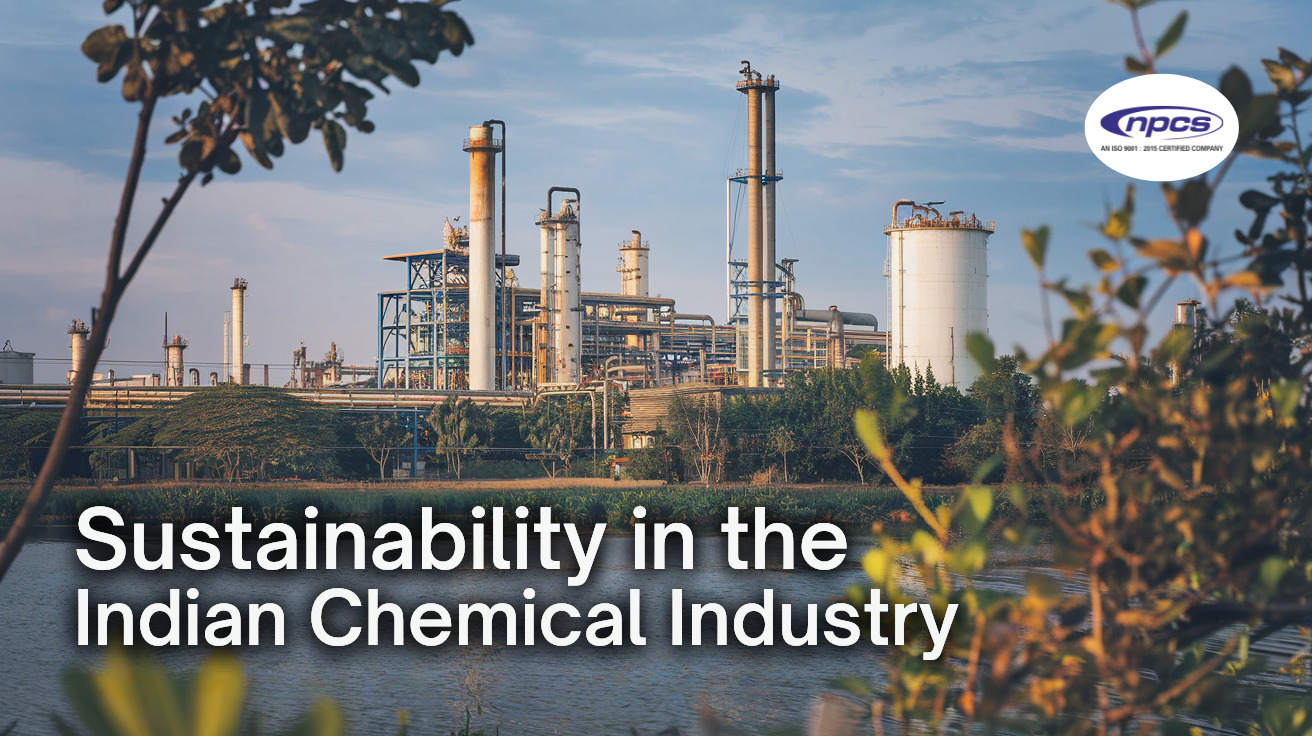The chemical industry in India occupies a special place in the structure of the gross domestic product of the country and plays an important role in industrial development and the provision of employment. Being a large producer of chemicals and petrochemicals, speciality chemicals, and agrochemicals, the sector has a tremendous contribution in fulfilling national as well as international requirements. Nevertheless, many environmental problems with this type of industry call for a shift toward more sustainable models. In this blog, we examine the path to sustainability in the chemical industry in India, the measures that are being taken, and the action plan required to promote environmental sustainability.
The Indian Chemical Sector: An Overview
The chemical industry, one of the major industries in India, stands sixth in global production. It forms a part of 7% of India’s gross domestic product (GDP) and represents 14% of India overall exportation. To meet the growing worldwide demand for speciality chemicals, agrochemicals, and bulk chemicals, India is emerging as a preferred global destination for chemical manufacture. It is also a diversified industry; there are over 80,000 commercial products from this sector, and it finds application in agriculture, pharmaceuticals, and textile industries.
The sector also receives 100% FDI under the automatic route in addition to being an important recipient of FDI in manufacturing plants and R&D centers. However, such success could not adequately address the pressing environmental issues like resource depletion, pollution, and climatic change that made many call for the sustainable utilisation of chemicals in India. These challenges need to be surmounted to guarantee the sector grows consistent with world standards in sustainability.
Challenges in Achieving Sustainability
- Dependence on Non-Renewable Raw Materials: The use of fossil fuels and other non-renewable raw materials raises the industry impact on the environment. This dependency also made the industry sensitive to global price changes as it has to import over ninety percent of its requirements.
- Energy-Intensive Processes: The manufacturing of caustic soda, speciality chemicals, and petrochemicals requires energy with resultant effects on greenhouse gas missions. Such processes can be characterised as inefficient, thus the resulting waste of energy resources.
- Waste Management Issues: This has resulted in soil and water pollution of chemicals that were inappropriately discarded by chemical manufacturers. Solving this necessitates using superior waste treatment and recycling methods.
- Water Scarcity: Water used in large-scale manufacturing affects communities and the ecology of the sector of interest. Chronic extraction to supply industries, for instance, power stations, can have the effect of worsening water shortages in a given region.
Sustainable Practices in the Indian Chemical Industry
Adoption of Green Chemistry
Green chemistry, in a broad perspective, involves synthesising products through green techniques when producing chemicals. The potential of the Indian chemical industry in the global market can be harnessed by replacing the proliferation of dangerous solvents and detrimental catalysts. It also comprises decreasing the byproducts and utilising the renewable feedstock, leading to environmentally friendly processes.
Renewable Energy Integration
The involvement of solar, wind, and biomass in manufacturing can decrease reliance on fossil energy in manufacturing. Some of the large chemical industries have already started with projects in adopting sustainable power sources. For example, switching from fossil fuels to solar energy for heating and other uses can greatly reduce emissions.
Advanced Wastewater Treatment
Evaluating the problem of water pollution can be solved by using technologies in the treatment of wastewater. This is especially so for industries that are concentrated in manufacturing regions close to urban centres. Membrane filtration, biotechnical wastewater treatment technologies, and zero liquid discharge systems are a few of the technologies with which water sustainability could be achieved.
Promoting Domestic Production
Incentives and policies promoting local manufacturing aim at import substitution and original equipment manufacturers, while supporting local industries and lengthening supply chains increases sustainability. Reliance on global MNCs is reducing as government-sponsored programs in manufacturing, such as Make in India, have helped the increase of domestic manufacturing capacity to make the chemical industry more self-sufficient.
Digital Transformation
The opportunity of AI, IoT, and blockchain helps to improve supply chain effectiveness and minimise losses. It also reduces and can monitor emissions and environmental laws.
Our Books
- Modern Technology of Petroleum, Greases, Lubricants & Petro Chemicals
- Detailed Project Profiles On 9 Selected Chemical Industries (2nd Edition)
Government Initiatives Supporting Sustainability
The Indian government has launched several initiatives to promote sustainability in the chemical sector:
- National Green Hydrogen Mission: Promotes the green hydrogen as feedstock for chemical and petrochemical industries. This is intend to achieve a reduction of consumption of fossil-based energy and hence the reduction of emissions.
- Sustainable Chemistry Initiative: Endeavours to promote research and development of sustainable optimum solutions for the chemical industry in India. As part of this mechanism, the research collaboration initiative welcomes multi-disciplinary research partnerships with public and private sectors.
- FDI Incentives: Some policies permitting 100% FDI under the automatic route have also drawn the investment in green technologies. They have motivated the creation of green industries to boost manufacturing efficiency.
- Perform Achieve and Trade (PAT) Scheme: This market-based structure encourages cost reduction of the industrial sector in relation to energy consumption while restraining emissions.
Our Project Reports
The Role of Industry Stakeholders
Collaboration Among Companies
The current challenge and its solution therefore lie in mutual cooperation between the chemical companies, policy makers, and researchers. For example, it is known that common research and development centres can save money and time for the development of new things. Industry associations can also serve their members as the source of standards towards sustainability as well as the source of knowledge.
Educating the Workforce
Education and training of employees on sustainability promotes industry capacity for absorbing new technologies and practices. Leadership, energy efficiency, waste, and green chemistry are some of the options that can help the workers to contribute to organisational sustainability.
Consumer Awareness
It also noted that raising awareness of the advantages of going green when buying products helps consumers apply pressure to force the chemical industries to adopt environmentally friendly production methods. Product labelling, certifications, and standards are also largely important in promoting green products and putting consumers in informed positions with regards to their purchase decisions.
Also Read
Success Stories in Sustainability
- Tata Chemicals: The company has also been a pioneer in implementing green initiatives such as utilising renewable energy to decrease CO2 emissions and direct liquid discharge elimination. It has set the pace in the industry in the aspect of investment in green technologies.
- UPL Limited: Being an agrochemical company, UPL has embraced precision farming and has also come up with the biochemical solutions. Their performance in resource-effective and waste eradication exercises has placed them on the international map.
- Aarti Industries: Currently, the company has applied energy savings in its operations and incorporated green chemistry concepts to minimise the negative impacts to the environment.
The Way Forward
The shift towards sustainability in the chemical industry in India must involve everyone now. Through proper adoption of green technologies, minimised use of raw materials, and proper ways of disposal of wastes, the industry can conform to the international world standards of sustainable development. Firms can also use the huge collection of material available in NIIR to find information and advice on environmentally friendly activities in the chemical industry.
It is, therefore, a valuable assistance to firms that use NIIR as a resource since it provides techniques to adopt sustainable practices. Starting with routine project reports and moving on to market analysis, NIIR is your solution for a greener tomorrow of the chemical industry in India. Their extensive sources provide needed information to address issues and capitalise on opportunities in this burgeoning sustainable industry.
Also Read
Conclusion
Three Dimensions of Sustainability: Sustainability is no more an option but a compulsion for the chemical industry of India. It is now apparent that for the industry to be able to meet the market demands as well as reduced environmental legislation, the industry has to adapt to the new environmental demands. This paper argues that it is possible for the Indian chemical industries to transition towards a more sustainable business model. Various strategies will thus be quite useful in attaining these objectives and maintaining India as a significant actor in the chemicals business.







